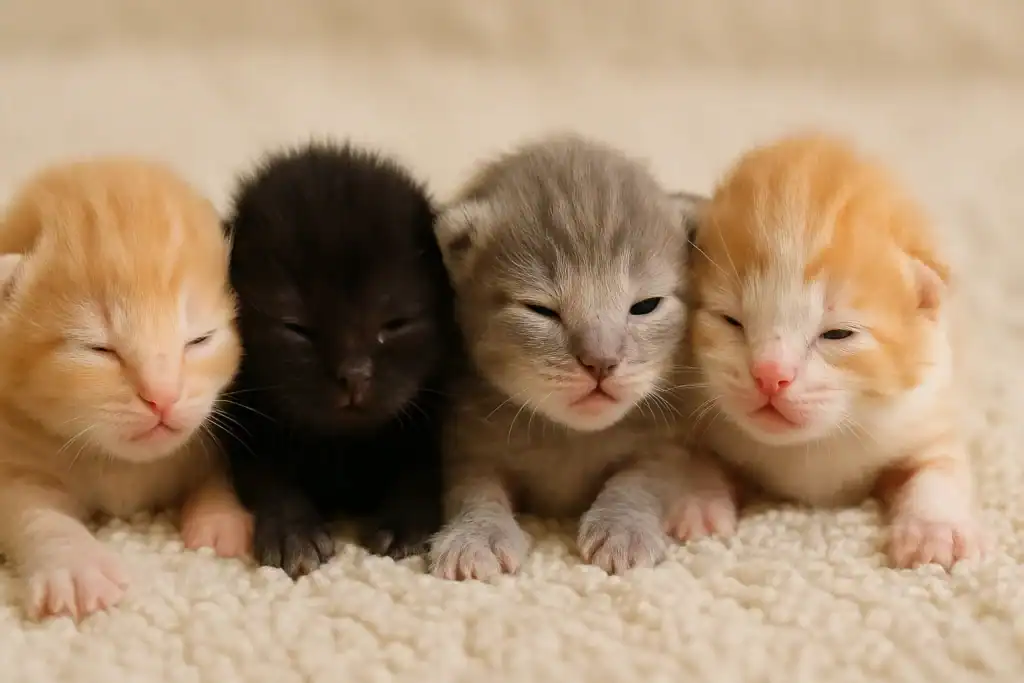Few sights are as heartwarming as a tiny, wobbly baby kitten. Those first few days are a flurry of sleeping, feeding, and soft purrs, but a common question often captures the attention of new cat parents and curious onlookers alike: When Do cats Open Their Eyes? It’s a pivotal moment in their early development, a transition from complete dependency in the dark to taking the first visual steps towards exploring their world. Understanding this timeline is crucial for ensuring the well-being of these vulnerable newborns. So, exactly when do these precious kitten eyes peek open?
Table of Contents
When Do cats Open Their Eyes? The Quick Answer
Generally, kittens begin to open their eyes between 7 and 14 days old. This process is gradual and often takes a couple of days to complete. Initially, the eyes may look cloudy or bluish, and they won’t be able to see clearly.

The Journey from Blindness to Sight: A Kitten’s Development
The first few days of a kitten’s life are marked by profound sensory limitations. Born blind and deaf, they rely entirely on their mother’s warmth, scent, and guidance. Their world is a tactile landscape of soft fur and the reassuring rhythm of her purr. This period is vital for gaining strength and growing rapidly.
So, how old are kittens when they open their eyes? As mentioned, the typical window is between one and two weeks of age. This timeframe isn’t set in stone, however. Several factors can influence exactly when do baby kittens open their eyes, including breed, individual development rate, and even their environment. For instance, some kittens might open a single eye slightly before the other, or one eye might open fully a day or two before its counterpart.
Kitten eyes, when they first appear, are a marvel. They are often a stunning shade of blue, regardless of the kitten’s eventual adult eye color. This is because the pigment in the iris, which determines adult eye color, hasn’t fully developed yet. Vision is blurry at this stage, and light sensitivity is high. The world, though now visible, is still a hazy landscape.
Stages of Eye Opening
The process of a kitten’s eyes opening is not an instant event. It unfolds in stages:
- Initial Slits: Around day 7, you might notice tiny slits starting to form in the corners of the eyelids.
- Gradual Widening: Over the next few days, these slits will gradually widen.
- Partial Opening: One eye might open partially or fully before the other.
- Full Opening: By day 14 (sometimes slightly later), both eyes should be fully open and rounded.
During this time, it’s crucial to provide a dark, quiet, and comfortable environment for the kittens. Bright lights can be harsh on their sensitive eyes.

What to Expect When Kitten Eyes Open
Once you see those little kitten eyes peeking out, a new phase of development begins. While they can see light and movement, their vision isn’t sharp. They still rely heavily on their sense of smell and hearing to navigate their surroundings and find their mother.
Their eye color will likely be a beautiful blue. This “kitten blue” is common because the melanocytes (pigment-producing cells) in the iris are not fully activated at birth. As the kitten matures and is exposed to light, these cells will start producing melanin, and their adult eye color will begin to appear. This process usually takes several weeks, sometimes even up to three months. The eventual color could be green, gold, copper, or remain blue in certain breeds.
It’s important to be patient and observe carefully during this period. Avoid trying to force their eyes open or touching them directly, as this can cause injury or infection.
| Age Range | Eye Development | Vision Capabilities |
|---|---|---|
| Birth – 7 Days | Eyes closed, fused eyelids. | Blind, rely on smell and touch. |
| 7 – 10 Days | Eyes begin to slit open. | Sensitive to light, blurred vision. |
| 10 – 14 Days | Eyes are largely or fully open. | Can detect movement and shapes, still blurry. |
| 2 – 3 Weeks | Vision improving, blue color apparent. | Starting to focus on objects, depth perception developing. |
| 3 – 4 Weeks | More coordination, exploring limited areas. | Better focus, distinguishing between objects. |
| 6 – 8 Weeks | Adult eye color may start appearing. | Vision significantly improved, more like adult cats. |
This table offers a general guideline for when kitten eyes typically follow certain developmental milestones.
When Should You Be Concerned?
While the window for when do baby kittens open their eyes is generally between 7-14 days, there are instances where you might need to consult a veterinarian.
- Eyes haven’t opened by 15 days: If a kitten’s eyes are still firmly closed after two weeks, it could indicate an underlying issue like infection or congenital conditions.
- Discharge or Swelling: Any signs of discharge (pus or sticky liquid), swelling, or redness around the eyelids or eyes should be addressed immediately. This could be a sign of a serious eye infection, such as conjunctivitis.
- Eyes open unevenly: While one eye opening before the other is common, significant delay or one eye consistently remaining closed or partially closed could be concerning.
If you notice any of these signs, gently clean around the eyes with a warm, damp (not dripping) cotton ball, moving from the inner corner outwards. However, avoid putting any drops or medications in their eyes without consulting a vet first. Early intervention is key to preventing permanent damage to their kitten eyes.
Keeping Those Kitten Eyes Healthy
Ensuring the health of a kitten’s eyes from the start is crucial for their long-term vision. Here are some tips:
- Maintain a Clean Environment: Keep the kittens’ bedding clean and dry to minimize the risk of infection.
- Monitor for Discharge: Regularly check their eyes for any signs of weeping, redness, or swelling.
- Protection from Irritants: Avoid using strong cleaning products or sprays near the kittens.
- Gentle Cleaning (if needed): If there’s mild crusting, you can gently wipe around the eyes with a warm, damp cotton ball. Always use a clean cotton ball for each eye to prevent spreading potential infections.
- Veterinary Care: Ensure the kittens receive timely veterinary check-ups. Their first vet visit is essential for assessing their overall health, including their eyes.
Remember, these tiny creatures are incredibly vulnerable. Providing a safe, clean environment and monitoring their development closely are the best ways to help them thrive. Understanding how old are kittens when they open their eyes allows you to anticipate this milestone and ensure everything is progressing as it should.
What Happens After Their Eyes Open?
Once kitten eyes are open and they can see, albeit blurrily, a whole new world opens up to them. They will become more active, start exploring their immediate surroundings (though still wobbly), and their personalities will begin to emerge.
Their ability to see improves rapidly over the next few weeks. By three to four weeks of age, they will be able to focus on objects, chase toys, and engage in playful interactions with their littermates. Their vision becomes sharper, and they begin to see in full color (though a cat’s color vision is different from a human’s).
This period, from the opening of their eyes to around eight weeks old, is a critical socialization window. It’s when they learn important social skills from their mother and littermates and start to become comfortable with human interaction.
Knowing when do cats open their eyes marks the beginning of this exciting phase of exploration and learning. It’s a joyous milestone for anyone caring for young kittens.

Frequently Asked Questions About Kitten Eyes
Here are some common questions people ask about when do cats open their eyes:
When do kittens start to open their eyes?
Kittens typically start to open their eyes between 7 and 14 days after birth.
How old are kittens when they open their eyes fully?
Most kittens will have their eyes fully open by the time they are two weeks old.
Do all kitten eyes start out blue?
Yes, nearly all kittens are born with blue eyes due to undeveloped pigment. Their adult eye color will appear later.
When do baby kittens open their eyes if they are born prematurely?
Premature kittens may open their eyes slightly later than the average, but it’s still usually within the two-week window. Consult a vet if you’re concerned.
What should I do if my kitten’s eyes are stuck together?
Gently clean the area with a warm, damp cotton ball. If there is persistent discharge or swelling, consult a veterinarian immediately as it could be an infection affecting the kitten’s eyes.
Can bright light damage a kitten’s eyes when they first open?
Yes, kitten eyes are very sensitive to light when they first open. Provide a calm, dimly lit environment to protect them.
Why are my kitten’s eyes cloudy after they opened?
A slight cloudiness can be normal initially. However, if it persists or worsens, or if there’s discharge, seek veterinary advice.
Data-Driven Insights into Kitten Eye Development
While the 7-14 day window is the general rule, data from veterinary clinics and kitten rescue organizations reveals some fascinating nuances in kitten eye development. For instance:
- Breed Variations: Some breeds, like Siamese and other Oriental breeds, are sometimes reported to open their eyes slightly earlier, potentially due to faster overall development in the early stages. Conversely, some larger or slower-developing breeds might fall towards the later end of the two-week range.
- Litter Dynamics: Observations suggest that within a litter, kittens who are more robust and gain weight quickly may also open their eyes sooner than smaller or less thriving littermates.
- Environmental Factors: A truly data-driven insight is the verifiable impact of adverse conditions. Cold temperatures, poor sanitation, or inadequate nutrition for the mother cat can significantly delay developmental milestones, including eye opening, and increase the risk of eye infections. Data shows a higher incidence of delayed eye opening and ophthalmological issues in kittens from challenging environments.
These data points underscore that individual variations are normal, but significant deviations or clusters of delayed development within a litter warrant closer attention and potentially veterinary consultation. They highlight the interconnectedness of a kitten’s overall health and the seemingly simple milestone of opening their eyes.
Beyond the Blue Gaze: When Adult Eye Color Appears
The transition from the striking “kitten blue” eyes to their permanent adult color is another captivating stage in their development. This transformation is driven by genetics and the activation of melanocytes, the cells responsible for producing pigment.
- The Melanin Process: As kittens grow and their eyes are exposed to light, the melanocytes in the iris begin to produce melanin. The amount and type of melanin produced determine the final eye color.
- Timeline for Color Change: This color change isn’t overnight. It usually begins subtly around 3-4 weeks of age and can take several weeks or even months to fully stabilize. By the time a kitten is 6-8 weeks old, you’ll likely start seeing hints of their adult color peeking through the blue. However, full color maturation can take up to 3-4 months, and sometimes even longer.
- Predicting Adult Color: While you can’t always definitively tell the adult color from the early blue, observing the parents’ eye colors can provide a clue. Genetics play a strong role. Common adult eye colors include shades of green, gold, amber, copper, and brown. Blue eyes in adult cats are typically seen in specific breeds like Siamese, Himalayans, and Ragdolls, or in cats with the epistatic white gene (where white fur masks other colors) where the blue eyes are often linked to deafness in one or both ears.
- Importance of Observation: During this period of color change, continue to monitor their eyes for clarity and health. The changing colors are a normal developmental process, but any signs of cloudiness that aren’t related to the color change, or any discharge, should still be addressed by a vet.
Understanding the timeline for adult eye color development adds another layer to appreciating the fascinating journey of a kitten’s vision, starting from that initial moment when their eyes first open. It’s a gradual reveal of their unique genetic makeup.
Personalized Recommendations for New Kitten Parents
Based on common scenarios new kitten parents encounter, here are some personalized recommendations:
- For the ‘Worried Watcher’: If you’re anxiously checking their eyes daily, remind yourself that the process is gradual. Focus on other signs of health and happiness – are they feeding well? Are they warm and safe? This perspective shift can reduce anxiety while still allowing you to calmly monitor for any concerning signs mentioned earlier.
- For the ‘Rescue Angel’: If you’ve rescued kittens, especially without their mother, you might see slight delays in development depending on their initial condition. Provide optimal warmth, nutrition (appropriate kitten formula!), and a clean environment. Gentle stimulation (like mimicking the mother’s licking with a soft cloth around their bottom) can also support their overall development. Be extra vigilant for signs of infection in orphaned kittens.
- For the ‘Excited Explores’: Once those eyes are open and kittens start to explore, childproof their area! Remove small objects they could swallow and ensure they can’t fall from high places. Introduce safe, age-appropriate toys that stimulate their developing vision and coordination.
- For the ‘Curious Kiddo’: If children are interacting with the kittens, educate them on the importance of being gentle, especially around the eyes. Supervised interaction is key during this vulnerable stage. Explain that the kittens are still learning to see clearly.
These personalized insights aim to address the diverse experiences of those caring for young kittens, making the information more relevant and actionable.
The Science Behind Those Blue Kitten Eyes
Delving a little deeper into the science behind the temporary blue eyes:
- Melanin Production: Melanin is produced by specialized cells called melanocytes within the iris. The amount and type of melanin determine the color. Eumelanin produces shades of brown/black, while pheomelanin produces shades of red/yellow. The combination of these pigments and how they reflect light creates the full spectrum of adult eye colors.
- Immature Melanocytes: At birth, the melanocytes in a kitten’s iris are present but largely inactive. They haven’t started producing significant amounts of pigment.
- Light Stimulation: Exposure to light after birth triggers the activation of these melanocytes. This is why the color change doesn’t begin until the eyes open.
- Structural Blue: The blue color seen in young kittens (and adult blue-eyed cats like Siamese) is not due to blue pigment. It’s a structural color. This happens when light enters the iris and is scattered by the stroma (the connective tissue layer) in a way that makes it appear blue, similar to why the sky appears blue. With little to no pigment to absorb light, this scattering effect is dominant.
- Pigment Overlays Blue: As melanin production begins, the pigment is deposited in the stroma. This pigment starts to absorb light at different
wavelengths, masking the underlying structural blue and revealing the true genetic color.
Understanding this scientific process adds another layer of appreciation for the remarkable development happening within those tiny kitten eyes.
Conclusion: Watching for That Special Glimpse
Witnessing the moment when do cats open their eyes is a truly magical experience. It signifies their transition from a completely dependent newborn to a small explorer ready to take on the world, one wobbly step and blurry glimpse at a time. Understanding the typical timeline, recognizing potential issues, and providing proper care for those delicate kitten eyes are essential parts of raising healthy, happy cats.
So, whether you’re a seasoned rescuer, a first-time foster parent, or simply intrigued by the wonders of feline development, keeping an eye out for that exciting two-week mark will bring you closer to those captivating baby kitten eyes as they begin to unfold. Knowing how old are kittens when they open their eyes empowers you to support them through this crucial stage. Enjoy the process, protect their health, and cherish those early glimpses into their world.




